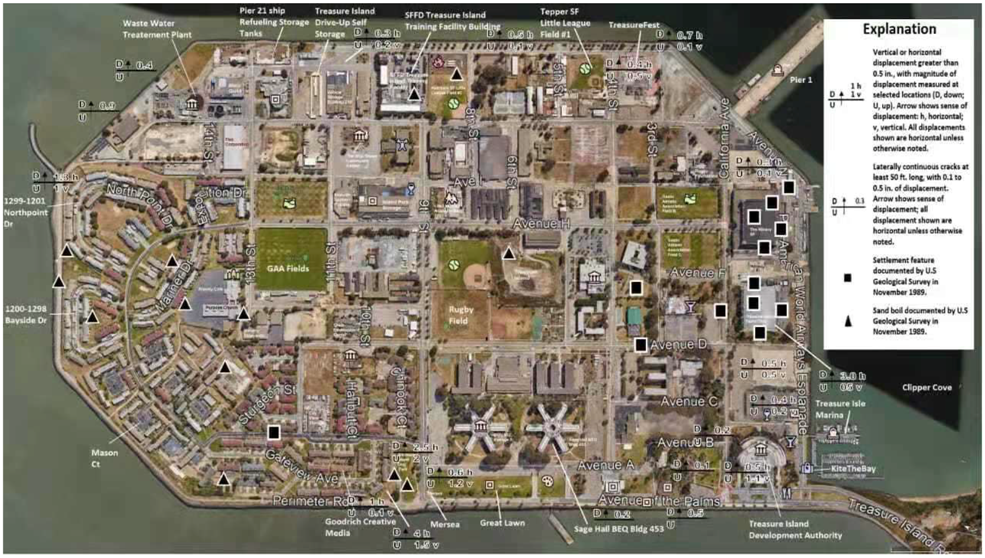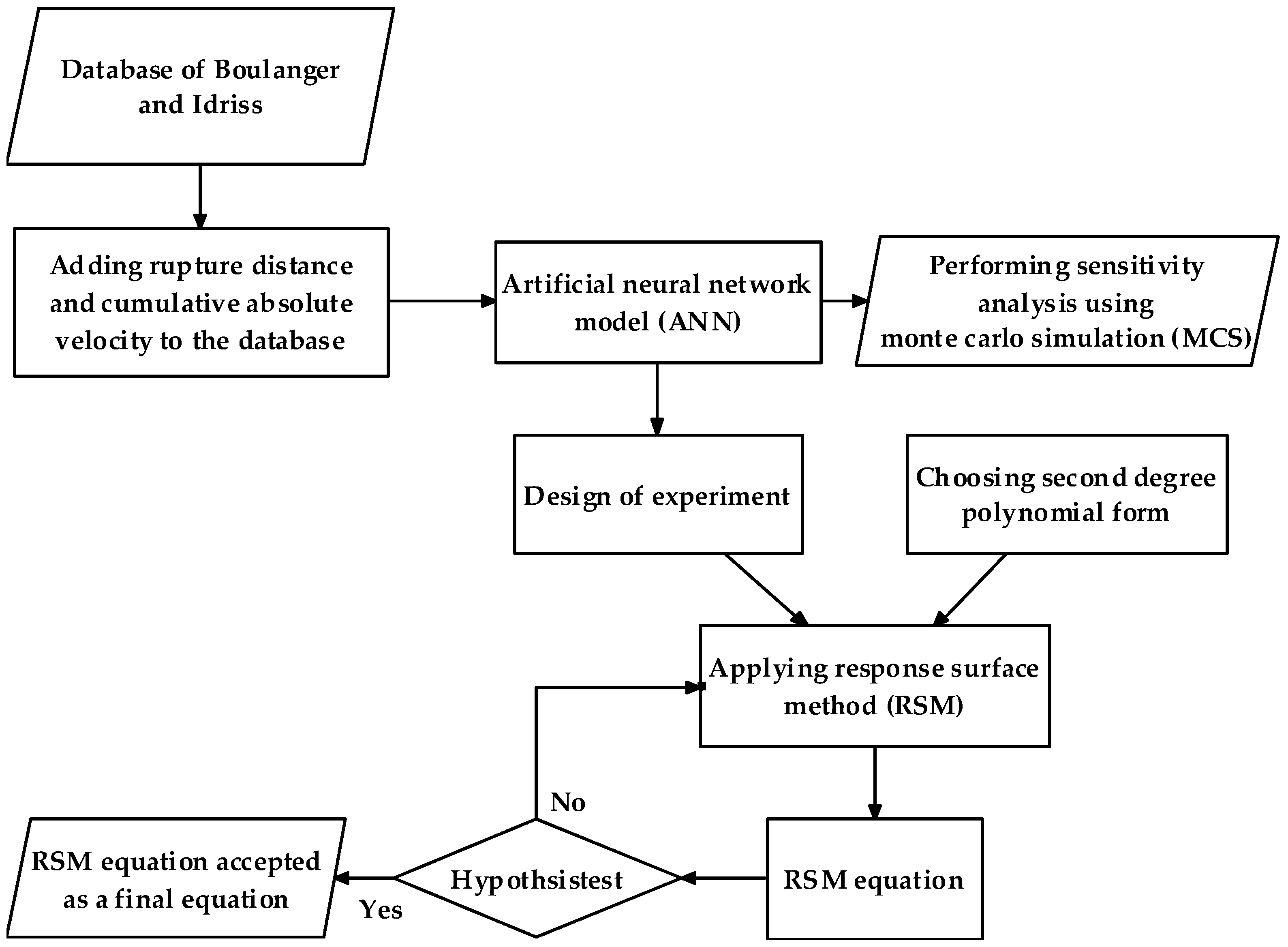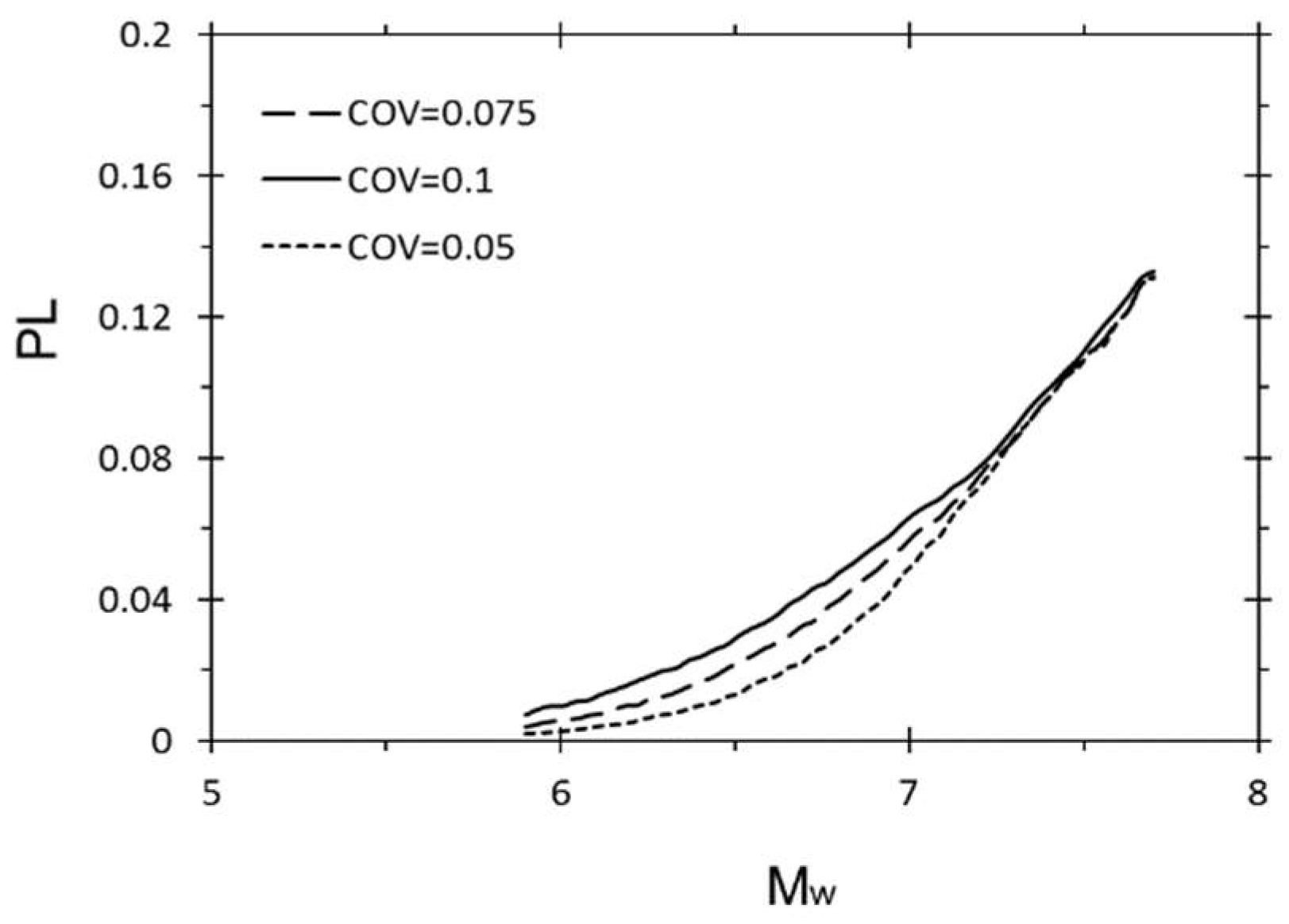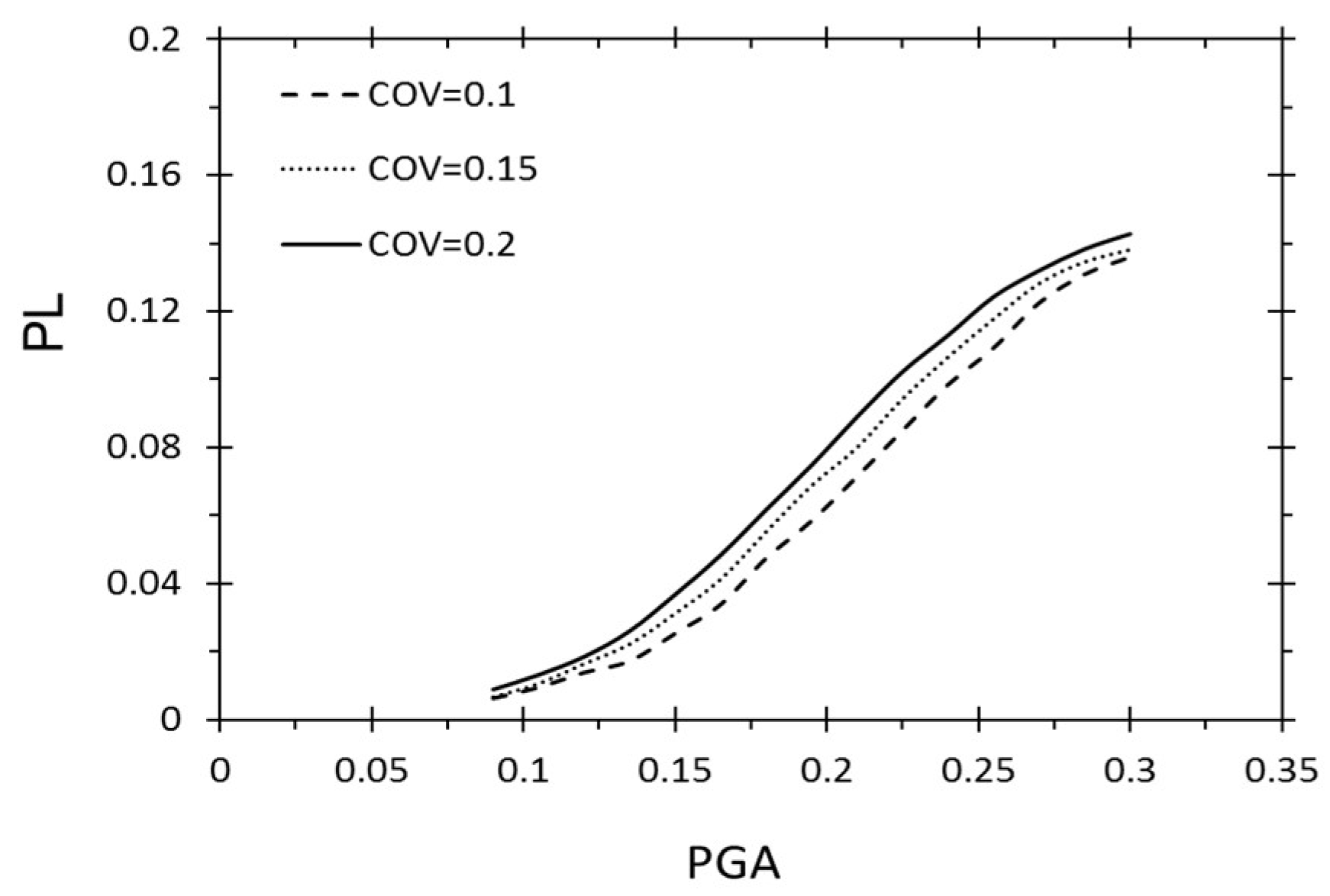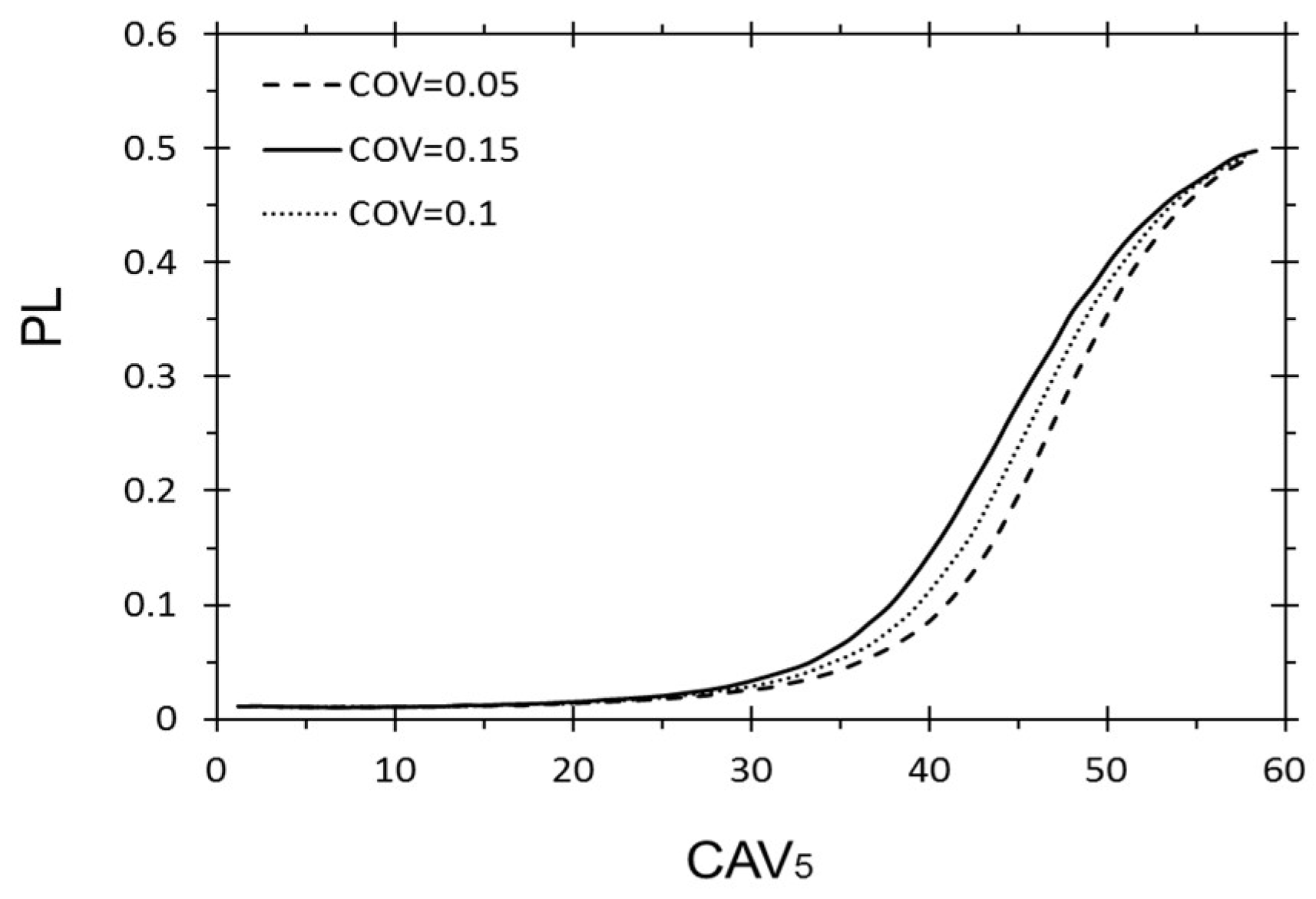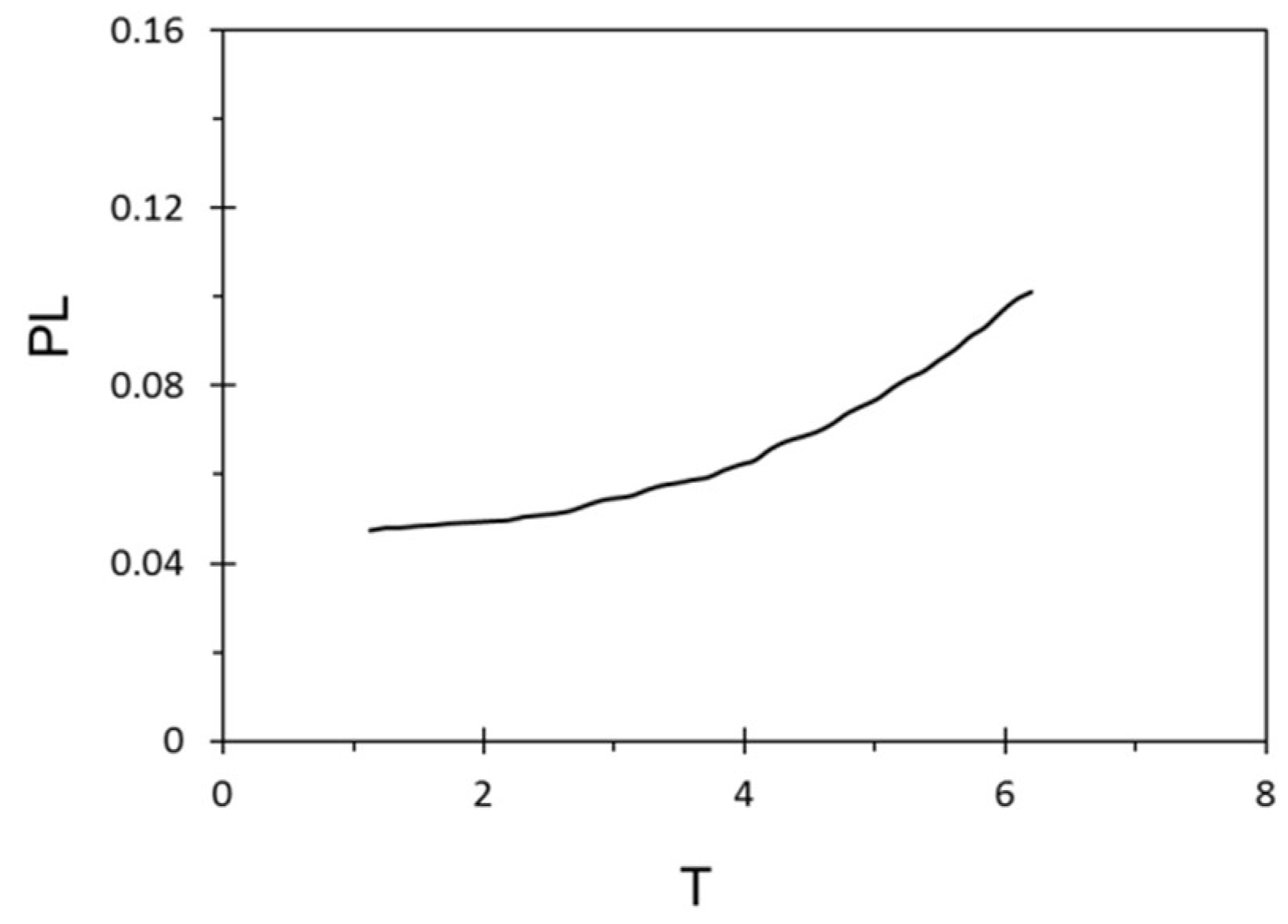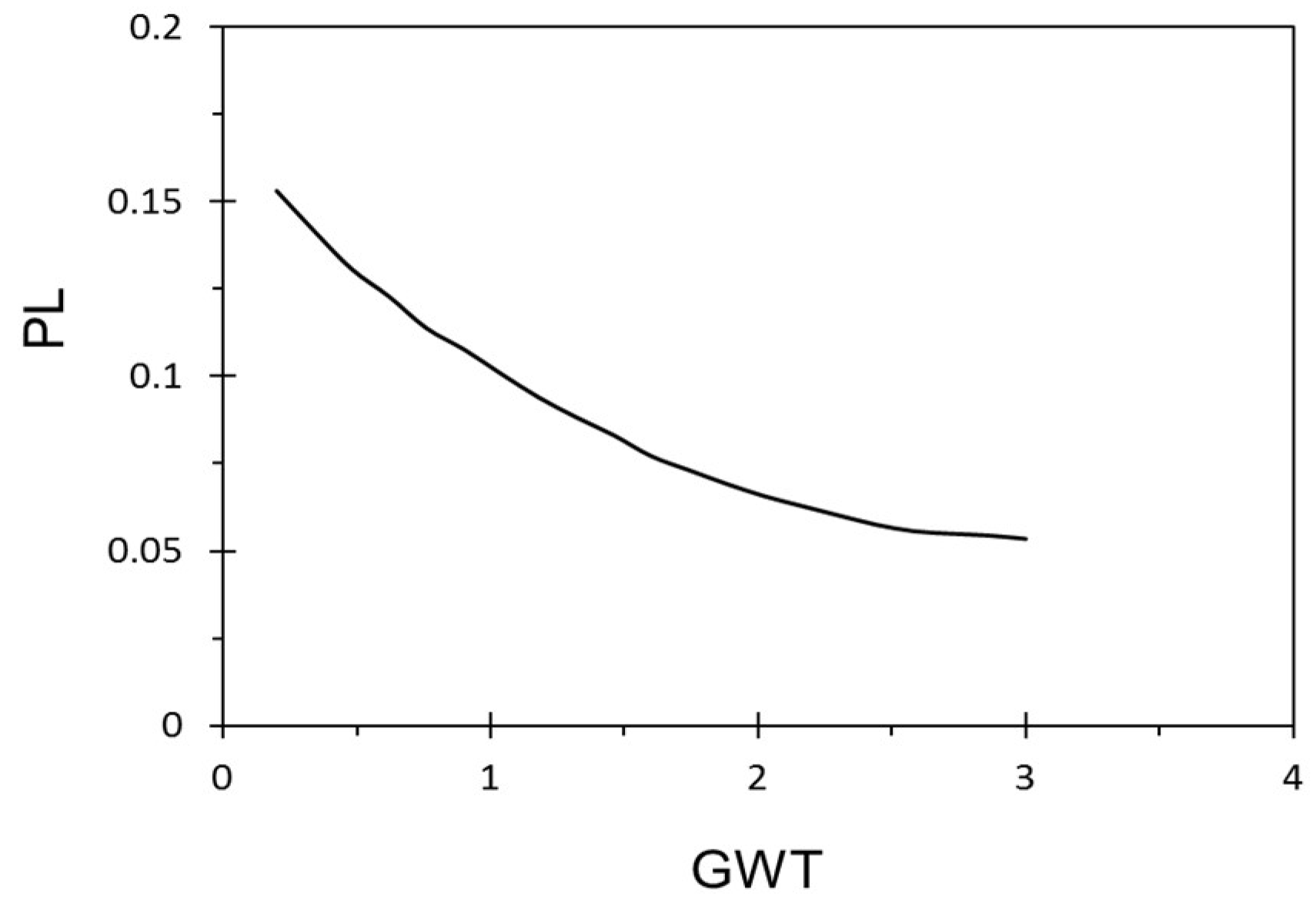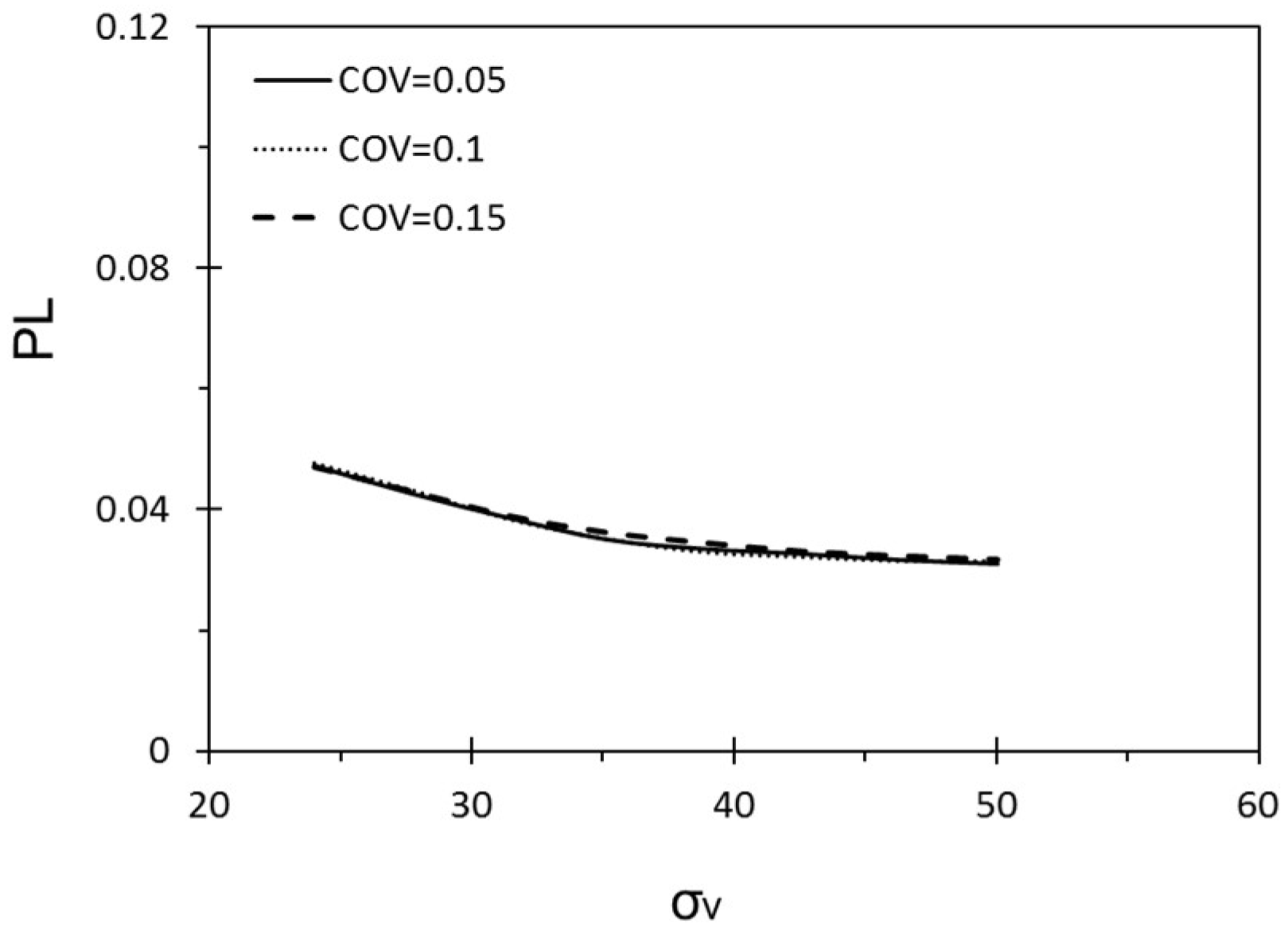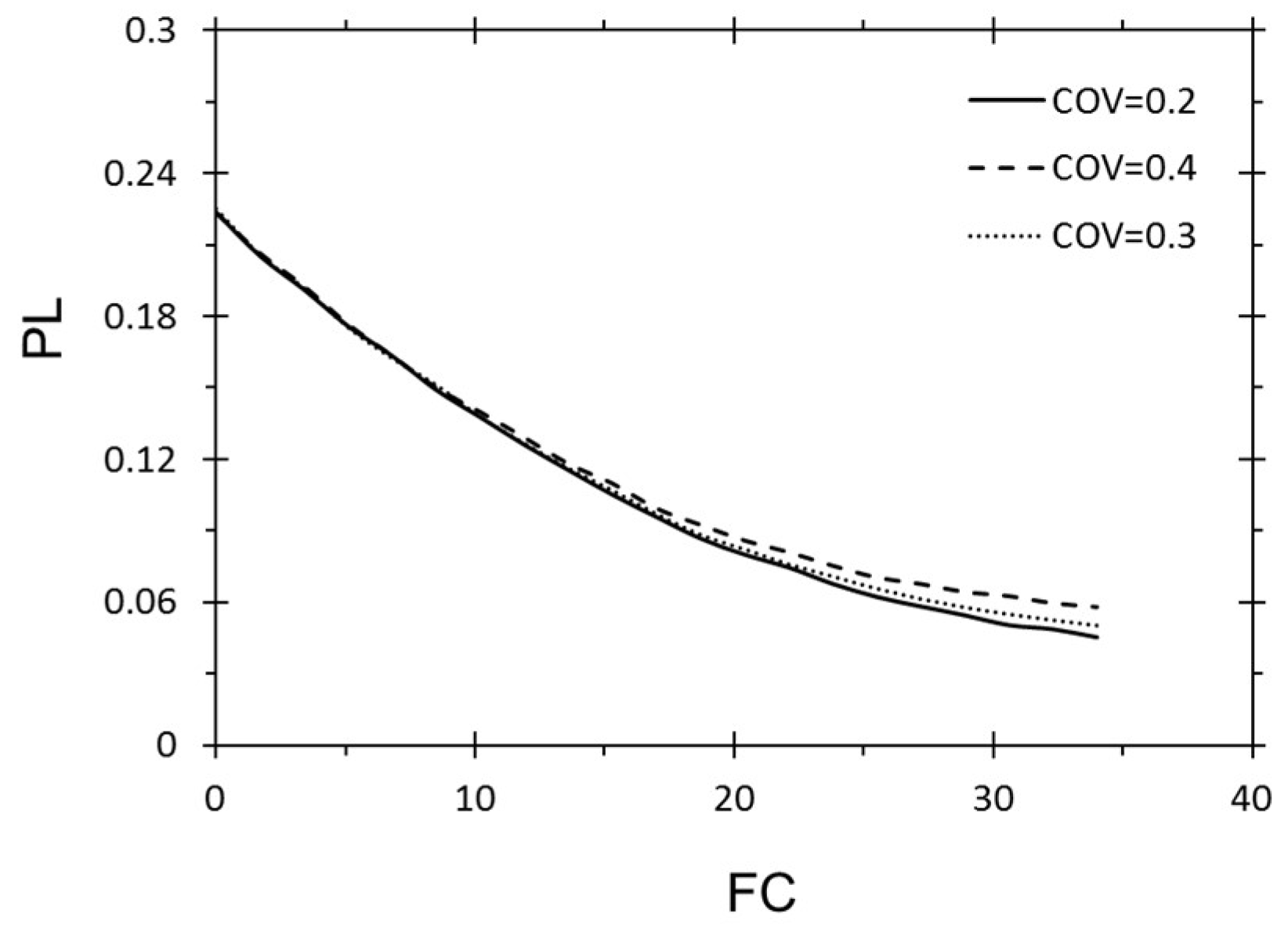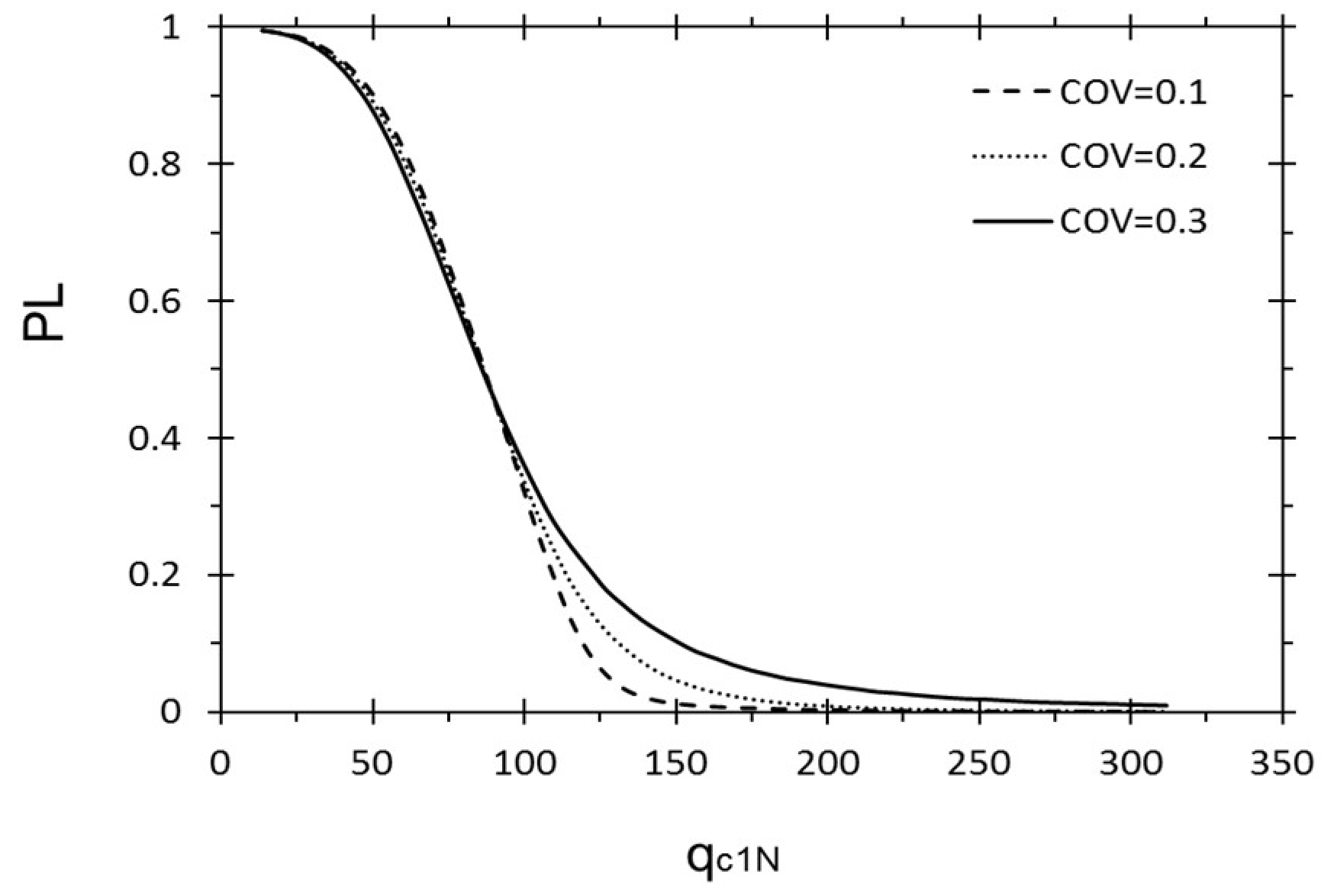1. Introduction
Nowadays, it is crucially important for engineers and urban planners to take sustainability, livability, and social health into account when considering natural disasters. The sustainability framework includes principles of sustainability in conjunction with hazard mitigation. Further, evaluating hazards and revising plans are two of the main steps of the classic planning approach [
1].
The subject of liquefaction started to garner a great deal of attention after two major earthquakes caused mortality and substantial damage in 1964. Massive landslides happened due to the liquefaction that occurred during the Alaska earthquake, which had a magnitude of 9.2 on the Richter scale, and demolished more than 200 bridges. During the Niigata earthquake, which had a magnitude of 7.5 on the Richter scale, excessive liquefaction caused major damage to more than 60,000 buildings and bridges, highways, and other urban city constructions. Liquefaction poses major threats to the sustainability of existing lifestyles.
Liquefaction occurs in saturated sandy soil due to the dynamic loads that occur during earthquakes. The rapid loads do not allow drainage, so pore water pressure increases, while at the same time effective stress goes down to be zero, or close to zero. Consequently, soil loses its shear strength, and liquefaction happens.
After several decades of intensive research on liquefaction, researchers have presented a variety of methods based on three approaches to evaluate its potential. These three approaches are (1) energy-based [
2,
3,
4,
5,
6,
7,
8,
9,
10,
11,
12], (2) cyclic stress-based [
13,
14,
15,
16,
17,
18,
19,
20], and (3) strain-based [
8,
9,
10,
11,
21,
22,
23,
24,
25,
26]. The energy-based models estimate the energy that is dissipated into the soil by earthquake loads. In the stress-based method, first, the cyclic stress ratio (CSR) and cyclic shear strength (CRR) are calculated; then, the potential of liquefaction is evaluated by comparing them. The strain-based models suppose that the cyclic shear strain loads control the increase in the pore water pressure. Empirical and semi-empirical methods based on the stress-based approach are more popular among researchers [
14,
27,
28]. Seed and Idriss [
29] developed a semi-empirical equation for the earthquake load by calculating the uniform cyclic shear stress amplitude.
Moreover, to determine soil liquefaction resistance, two types of methods have been used to measure the cyclic resistance ratio (CRR) and then compare it with the cyclic stress ratio (CSR): laboratory test-based methods and in situ test-based methods.
Some studies, such as those of Robertson and Wride [
13], Youd et al. [
14], Juang et al. [
27], and Rezania et al. [
28], have conducted deterministic analysis to calculate the factor of safety (FS), but due to uncertainty in the liquefaction phenomena, some other researchers have performed probabilistic analysis [
7,
16,
27,
30,
31,
32,
33,
34,
35]. Artificial neural network (ANN) is a strong technique in cases with non-linear correlations between parameters, such as the liquefaction phenomena. Hence, ANN has been used to investigate this issue [
31,
36,
37,
38]. However, the data division is conducted randomly in two groups for the testing and training phase, and there is no validating phase to prevent over-training the model. The validating phase is applied to minimize the over-fitting of the trained model. If the accuracy of the training dataset goes up, but the accuracy of the validation dataset decreases, then over-fitting occurs, and the training should be stopped. Goh [
36] was the first to use a simple back-propagation ANN algorithm to find the relationship between the soil and seismic parameters, and the liquefaction potential. He examined the following eight parameters: SPT value (
N1,60), fines content (
FC), mean grain size (
D50), equivalent dynamic shear stress (
τav/σ’v),
σv,
σ’v,
Mw, and peak horizontal ground acceleration (
PGA). His results showed that
N1,60 and
FC are the most influential parameters, and he compared his ANN results with those of Seed et al. [
39]. In another study, Baziar and Nilipour [
38] used STATISCA neural networks to evaluate the potential of liquefaction. They confirmed that neural networks (NN) are a capable tool for analyzing liquefaction.
Applying fuzzy neural network models to predict liquefaction, Rahman and Wang [
40] considered nine parameters: magnitude of the earthquake (
M), vertical total overburden pressure, vertical effective overburden pressure,
qc1N value from CPT, acceleration ratio
PGA/g, CSR, median grain diameter of the soil, critical depth of liquefaction, and water table depth. They combined fuzzy systems and NN to use both systems’ advantages: the learning and optimization ability of NN, and the human-like analysis of the fuzzy system to consider the meaning of high, very high, or low. Their databases included 205 field liquefaction records from more than 20 major earthquakes between 1802–1990. On the other hand, Hanna et al. [
31] used the generalized regression neural network (GRNN) to find the liquefaction potential of soil. They considered 12 soil and seismic parameters from the two earthquakes that occurred in Turkey and Taiwan.
All in all, ANN models that assess the potential of liquefaction are still lacking. A validating phase is missing to prevent the model from overtraining. Furthermore, data division has been performed randomly without attention to statistical aspects of the databases.
According to Kramer and Mitchell [
41], the ground motion caused by earthquakes can be affected by an earthquake’s fault type characteristics. Furthermore, the stress energy carried by earthquake waves decreases exponentially with epicentral distance (
Repi). Takahashi et al. [
42] investigated the influence of the faulting mechanism on the motions caused by earthquakes, and defined, for example, reverse faulting in comparison with strike-slip and normal faulting shows around 30% higher spectra acceleration. Furthermore, near-fault zones experienced high peak horizontal ground acceleration (
PGA) with high frequency and a short period, with a less active load on structures [
43] and no liquefaction occurrence [
44,
45]. In an investigation of large-scale Japanese earthquakes, Orense [
45] discovered some seismic records in Japan with a high frequency. Even with large acceleration, he observed no liquefaction. Therefore, he proposed the threshold for peak ground velocity (
PGV) and
PGA for the occurrence of liquefaction. Furthermore, Liyanapathirana and Poulos [
44] analyzed some earthquakes from all around the world and compared them with characteristics of Australian earthquakes. They indicated that the low value of cumulative absolute velocity (
CAV of Australian earthquakes, which is the time integration of the absolute values of the acceleration, is the key reason for their lack of liquefaction, even with high
PGA.
It has been demonstrated that the earthquake intensity measure (
IM) with the best combination of efficiency and sufficiency is standardized cumulative absolute velocity (
CAV5) [
41,
44]. However, no study has explored its influence and correlation with liquefaction in empirical or semi-empirical models. Furthermore, to the best of the present authors’ knowledge, the studies that have been performed did not take into account the effectiveness of parameters and their uncertainties, according to the use of CRR and CSR, on the triggering of liquefaction.
In this study, the most essential parameters to evaluate the potential of liquefaction are selected according to background research studies [
7,
13,
15,
16,
27,
28,
30,
31,
46,
47,
48,
49,
50]. Then, two new earthquake parameters added to the dataset to create a comprehensive database:
CAV5 and the closest distance from the site to the rupture surface (
rrup). So, strict consideration was given to the earthquake parameters in addition to the soil properties and geometry of the sites. The new earthquake parameters (
CAV5 and
rrup) were estimated through attenuation equations derived by Kramer and Mitchell [
41] and Sadigh et al. [
51], respectively. Consequently, this study considers the influence of earthquakes’ causative fault type, the effect of earthquakes near the fault zone, and the frequency of earthquakes’ load. In the first step, data are collected to develop an ANN model. To achieve this goal, the data are divided by considering their statistical aspects instead of random division. Furthermore, the data are divided into three groups for the training, testing, and validating phase to prevent the overtraining of the model.
Then, the design of experiment (DOE) is conducted to cover all of the ranges of parameters by points. The ANN model is applied to estimate the target of DOE sample points. Subsequently, the response surface method (RSM), which is a novel method regarding risk assessment and the hazard analysis of liquefaction, is used to establish a direct equation to evaluate the triggering of liquefaction instead of using CRR and CSR. This makes is easier for engineers and contractors to use. Finally, due to uncertainties in soil properties and earthquake parameters, on the basis of the ANN model that was developed in this study and through Monte Carlo simulation (MCS), sensitivity analysis is performed to show the effect of the parameters and their uncertainties on the potential of liquefaction in sandy soils. In
Section 8, the proposed model to evaluate the potential for liquefaction triggering (PL) is described. The developed ANN and RSM models are presented in
Section 9. The capability and accuracy of the models are confirmed by comparing their results with three extra well-known models. Finally, the sensitivity analysis results are illustrated in 10 graphs.
Figure 1 illustrates the flowchart of the risk assessment performed in this study to evaluate PL and conducting sensitivity analysis.
5. Response Surface Methodology
The response surface method (RSM) consists of some statistical techniques, and supports Taguchi’s philosophy [
56] regarding mathematical processes to build a model and optimize a response. In the present study, the RSM is applied to establish a correlation between parameters. To achieve this goal, three main steps were followed:
Choosing a reasonable design of experiment (DOE).
Selecting an approximate mathematical form.
Determining the significance of equation terms through hypothesis testing.
The first step is choosing a sampling point or experimental design. There are several kinds of DOE techniques, such as central composite design, minimum design, D-optimal designs, full factorial design, Taguchi’s contribution design, star design, and Latin hypercube design. In this study, to examine a range of parameters and prevent a negative value in the DOE [
57], the design of Box and Behnken [
58] is applied. Furthermore, to find the sampling point space, an ANN is applied. According to the DOE and 10 input parameters, 170 sample points are produced by the RSM. To estimate the target (response) of these samples, which is called a coded value here, an ANN model that was trained with a case history database was applied. The coded values for any sample are as follows: The Max value is supposed to be (+1), the mean value is supposed to be (0), and the Min value is supposed to be (−1).
The second step of a RSM is choosing a suitable approximation form to present the relationship between the target (response) and inputs. This is the difference between the RSM and genetic programming.
The most common response surface form that researchers use is polynomial forms, which are given by:
To identify significant terms in the equation, a hypothesis test is conducted in the last step. A hypothesis test evaluates the terms relating to a population to determine which terms are the best supported by the sample data. By considering the p-value, some expressions are eliminated in order to achieve the most effective and meaningful terms to build the final equation.
It is common to use hypothesis testing based on p-values in statistics such as basic statistics, linear models, reliability, and multivariate analysis. The p-values have a range from 0 to 1, and show the probability of obtaining a test statistic that is at least as extreme as the calculated value when the null hypothesis is correct.
7. Case History Database
This study uses an updated version of the liquefaction CPT database case histories from Boulanger and Idriss [
19]. It contains a total of 253 cases in which
IC < 2.6.
IC is the soil behavior type index presented by Robertson and Wride [
13] to classify soils based on fine content. The index ranges from 0.5 for sands to 1.0 for clays, and is given by:
where:
Of all cases, 180 contained surface evidence of liquefaction, 71 cases did not, and two included doubtful evidence. The common
Ic border value of 2.6 [
13] is applied to eliminate soils with a clay treatment; therefore, the 15 cases with
Ic ≥ 2.6 are not used in this study. Around 30% of all of the samples belonged to the 1989 Loma Prieta earthquake, including 76 case history samples. The map of liquefaction and its associated effects can be seen in
Appendix A and
Appendix B, in the southern part and the northern part, respectively. Next to that,
Appendix C illustrates the locations of the ground failure and damage to the facilities on Treasure Island that were attributed to the 1989 Loma Prieta earthquake. These figures illustrate the ground failure sites, lateral spread, ground settlement, sand boil points, and cracks that were caused by liquefaction in this area.
The dataset contains two earthquake parameters: moment magnitudes (
Mw) and
PGA. Given that the purpose of this study is to consider the new earthquake parameters (
CAV5 and
rrup), Kramer et al.’s [
41] equation is used. Due to the shortage of known parameters to apply this equation, the causative faulting mechanism of all of the earthquakes in the dataset is first characterized to utilize both equations. Then, Sadigh et al.’s [
51] attenuation equation is applied to estimate the
rrup. Next to that, due to the magnitude range of the attenuation equations, the seven data samples from the Tohoku earthquake, with a moment magnitude of nine, are eliminated from the dataset. From all of the parameters in the source, only eight are selected according to studies reported in the literature [
7,
13,
15,
16,
27,
28,
30,
31,
46,
47,
48,
49,
50]: momentum magnitude (
Mw),
PGA(
g), thickness of liquefiable soil (m) (measured from critical depth interval)(
T), ground water table
GWT (m), overburden stress (
σ) (kPa), effective overburden stress (
σ’) (kPa), normalized con penetration test result tip (
qc1N), mean grain size (
D50), and fine content (
FC) (%). The two extra parameters of
CAV and
rrup are added to the dataset through Equations (9) and (10) Therefore, the study considers some of the essential aspects of the earthquakes, such as the near-fault earthquake zone and causative fault type of the earthquake. The summary of the dataset that is used in this study can be seen in
Table 1.
8. Proposed Model and Equation to Evaluate Liquefaction Triggering
The dataset that was collected for this study is illustrated in
Table 1. As can be seen, it includes 246 samples: 68 non-liquefied samples, 176 liquefied samples, and two doubtful samples [
19]. The same portion of liquefied and non-liquefied samples is selected for division, instead of a randomness division. As can be seen from
Table 1, around 18% of the liquefied samples, or 32 samples, are selected for the ANN testing phase, and an equal number is selected for the validating phase. A similar ratio of non-liquefied samples is chosen, too. Twelve samples from a total of 68 are chosen for testing, and an equal number is selected for the validating phase.
Furthermore, the parameters are divided into three parts based on similar statistical characteristics, such as the mean value and mean coefficient of variation (COV), in order to increase the accuracy and capability of the trained model. Single hidden layer neural network training was developed in conjunction with the back-propagation algorithm to train a model [
36,
37,
38]. In addition, the ANN target to evaluate the potential for liquefaction according to the dataset is introduced as:
The new equation is presented by applying the new tool for the response surface method (RSM). To the best of the authors’ knowledge, no approach has yet used this tool to assess liquefaction in sandy soil. In the present study, the RSM is applied to develop correlations between the input parameters and the target. The ANN model is used to calculate the coded points, which are defined in
Section 4. The new equation presented herein has two advantages over the processes and models that have been presented by other researchers:
Some aspects of earthquakes, such as the near-fault sites and the frequency content of earthquake motions, are considered by exploring and adding the two new parameters of CAV5 and rrup.
Since it uses direct parameters instead of just CRR and CSR, it is simpler to use in projects by engineers and city planners to obtain sustainable design.
Since the equation uses direct parameters, extra statistical and probabilistic aspects are considered during sensitivity analysis. In contrast, when analyzing liquefaction through CRR and CSR, it is only possible to consider model uncertainty, not parameter uncertainties.
In this study, the second-degree polynomial with cross terms (Equation (14)), which is the most frequently utilized form, is applied to derive a final equation. The alpha (
α) level of 0.05 is commonly used by scientists and researchers, and is considered herein. This means that if the
p-value of a test statistic is less than alpha, which is herein 0.05, then the null hypothesis is rejected. Here, the null hypothesis is that there is no meaningful correlation between the input value and the target, so the expressions with a
P-value of more than 0.05 are eliminated. Furthermore, according to Equation (18), the following values are supposed to evaluate the results of an ANN and the RSM:


